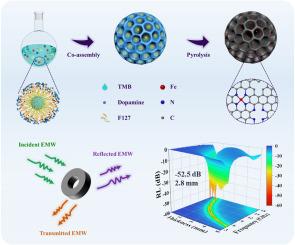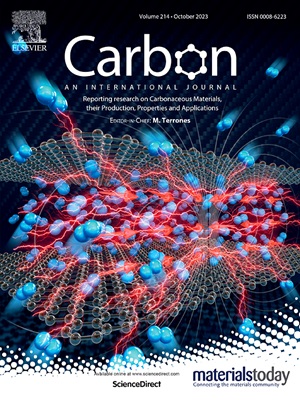Mesoporous carbon spheres modified with atomically dispersed iron sites for efficient electromagnetic wave absorption
IF 10.5
2区 材料科学
Q1 CHEMISTRY, PHYSICAL
引用次数: 0
Abstract
Carbon materials have obtained some achievements in electromagnetic wave (EMW) absorption owing to their excellent electrical conductivity and low density. However, poor impedance matching and high electrical conductivity limit their EMW absorption properties. Metal single atoms absorbers have garnered considerable attention in EMW absorption, largely due to the high metal availability and special coordination structure, but the modulation of the EMW absorption properties still needs to be improved. Herein, atomically dispersed Fe sites embedded into the N-doped mesoporous carbon spheres (Fe–SAs/NC) were synthesized through a facile coordination-assisted polymerization assembly strategy without acid leaching treatment. Benefitting from abundant mesoporous structure, the Fe–SAs/NC displays large specific surface area (339 m2 g−1) and optimized impedance matching, which results in an effective reduction of the absorber density. The homogeneously dispersed Fe single atoms (Fe–SAs) on the carbon skeleton lead to the improvement in conduction and dipole polarization losses of Fe–SAs/NC, which endows Fe–SAs/NC with exceptional EMW absorption properties. Experimental results indicate that Fe–SAs/NC displays desirable EMW absorption properties with the minimal reflection loss of −52.5 dB at 2.8 mm and the effective absorption bandwidth of 4.8 GHz. The study provides valuable insights for the development of carbon materials modified with atomically dispersed metal sites to achieve high-efficient EMW absorbers.

用原子分散的铁位点修饰介孔碳球以实现高效电磁波吸收
由于碳材料具有出色的导电性和低密度,因此在电磁波吸收方面取得了一些成就。然而,阻抗匹配性差和高导电性限制了其电磁波吸收特性。金属单原子吸收体在电磁波吸收方面受到了广泛关注,这主要得益于其较高的金属可用性和特殊的配位结构,但其电磁波吸收特性的调制仍有待改进。本文通过一种无需酸浸处理的简便配位辅助聚合组装策略,合成了原子分散的嵌入 N 掺杂介孔碳球(Fe-SAs/NC)的铁位点。得益于丰富的介孔结构,Fe-SAs/NC 显示出较大的比表面积(339 m2 g-1)和优化的阻抗匹配,从而有效降低了吸收剂密度。碳骨架上均匀分散的铁单质原子(Fe-SAs)改善了 Fe-SAs/NC 的传导和偶极极化损耗,使 Fe-SAs/NC 具有优异的电磁波吸收特性。实验结果表明,Fe-SAs/NC 具有理想的电磁波吸收特性,在 2.8 毫米处的最小反射损耗为 -52.5 dB,有效吸收带宽为 4.8 GHz。这项研究为开发具有原子分散金属位点修饰的碳材料以实现高效电磁波吸收器提供了宝贵的见解。
本文章由计算机程序翻译,如有差异,请以英文原文为准。
求助全文
约1分钟内获得全文
求助全文
来源期刊

Carbon
工程技术-材料科学:综合
CiteScore
20.80
自引率
7.30%
发文量
0
审稿时长
23 days
期刊介绍:
The journal Carbon is an international multidisciplinary forum for communicating scientific advances in the field of carbon materials. It reports new findings related to the formation, structure, properties, behaviors, and technological applications of carbons. Carbons are a broad class of ordered or disordered solid phases composed primarily of elemental carbon, including but not limited to carbon black, carbon fibers and filaments, carbon nanotubes, diamond and diamond-like carbon, fullerenes, glassy carbon, graphite, graphene, graphene-oxide, porous carbons, pyrolytic carbon, and other sp2 and non-sp2 hybridized carbon systems. Carbon is the companion title to the open access journal Carbon Trends. Relevant application areas for carbon materials include biology and medicine, catalysis, electronic, optoelectronic, spintronic, high-frequency, and photonic devices, energy storage and conversion systems, environmental applications and water treatment, smart materials and systems, and structural and thermal applications.
 求助内容:
求助内容: 应助结果提醒方式:
应助结果提醒方式:


